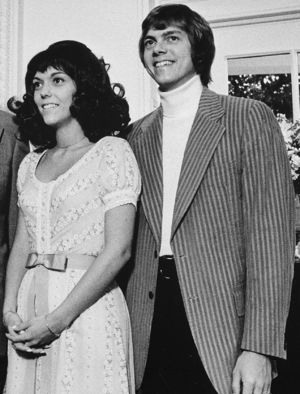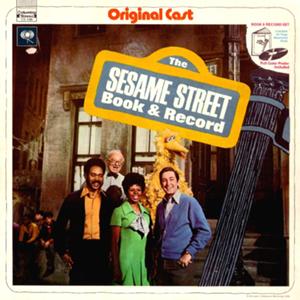Music of Sesame Street facts for kids
Music has been a huge part of the famous children's TV show Sesame Street since it first aired on PBS in 1969. For the first time, songs were used on a TV show to help kids learn. The songs written for the show had special goals and supported what the show was teaching. Sesame Street music used many different styles, but it always sounded the same and was easy to recognize.
The show's creators released many music albums. Many songs became "timeless classics." To get the best songwriters, the creators let them keep the rights to their songs. This meant songwriters could earn good money. The album Sesame Street Book & Record, made in 1970, sold a lot and won a Grammy. In 2019, Sesame Workshop teamed up with Warner Music Group to bring back Sesame Street Records. This made all the show's music widely available.
Some of Sesame Street's main songwriters were the first music director Joe Raposo, Jeff Moss, and Christopher Cerf. Scriptwriters like Tony Geiss and Norman Stiles also wrote songs. Joe Raposo and his team created a huge amount of music, sometimes dozens of new songs for each show. Raposo was inspired by Sesame Street's goals and wrote hundreds of songs for the lessons. He won three Emmys and four Grammys for his work. The "Sesame Street Theme" song, also called "Sunny Day," was written by Raposo, director Jon Stone, and writer Bruce Hart. Raposo also wrote "Bein' Green," "Somebody Come and Play," and "C is for Cookie." The song "Sing" became a hit for The Carpenters in 1973. Jeff Moss wrote "I Love Trash" and "Rubber Duckie." "Rubber Duckie" was performed by the Boston Pops and reached #11 on the Billboard Hot 100 chart in 1971. Moss also wrote "I Don't Want to Live on the Moon" and "People in Your Neighborhood."
Famous artists like Barbra Streisand, Lena Horne, Dizzy Gillespie, Paul Simon, and Jose Feliciano have recorded Sesame Street songs by Raposo. By 2019, Sesame Street had won 11 Grammys.
Why Music Matters on Sesame Street
From the very start, Sesame Street used music to teach kids. The show's creators noticed that children loved catchy TV jingles. So, they decided to use similar ideas in their songs. These ideas included repeating things, using fun visuals, keeping it short, and making it clear. For the first time on children's TV, the songs had a special purpose. They supported what the show was trying to teach.
The creators knew that music and sounds were a direct way to teach kids basic skills. Children learned better when new information came with a song. Joan Ganz Cooney, one of the show's creators, wrote in 1967 that children loved "commercial jingles." Because of this, many of the show's songs were made like TV ads. One critic said, "If [children] could sing Budweiser jingles, why not give them a show that teaches ABCs and numbers?"
The music on Sesame Street had many styles. But it always had its own special sound. This sound was consistent and easy to recognize. Jon Stone, the show's first director, said, "There was no other sound like it on television." Music helped kids pay attention to the show's action, even when they weren't actively watching.
Gerald S. Lesser, who led the research for Sesame Street, said that music and sounds make kids want to move. So, they had to be carefully matched with what was happening on screen. Songwriters avoided putting music with still pictures. Music or sound effects would signal when a character appeared or when a scene began or ended.
Famous Songs and Their Writers

Sesame Street had amazing songwriters. These included the first music director Joe Raposo, Jeff Moss, and Christopher Cerf. Scriptwriters like Tony Geiss and Norman Stiles also wrote many songs. Tony Geiss wrote about 150 songs for the show.
Joe Raposo was brought to Sesame Street by his friend Tom Whedon and director Jon Stone. Stone thought Raposo's music was brilliant and catchy. It was also simple enough for kids to understand and sing. The unique sound of Sesame Street came from recording sessions with a seven-person band. This band included a keyboardist, drummer, bass player, guitarist, trumpeter, a winds player, and a percussionist. Danny Epstein, the drummer, became the show's music coordinator in 1970.
Raposo and his music team created a huge amount of music. They needed songs for 130 episodes each year, often with dozens of new songs per show. Raposo wrote over 2,000 songs for Sesame Street. He was very inspired by the show's goals, especially in the early days. He wrote many songs that fit the show's lessons. Researchers enjoyed working with Raposo. He would change his songs based on their ideas and the show's teaching goals. Raposo won three Emmys and four Grammys for his work on the show.
Raposo wrote the music for the "Sesame Street Theme" song, also known as "Sunny Day." Jon Stone and writer Bruce Hart wrote the lyrics. Danny Epstein helped bring in jazz musician Toots Thielemans to play harmonica for the song. The music has changed a few times over the years, but the words have stayed the same. "Sunny Day" has become a very popular song for young children.
Jeff Moss was called a "true music visionary." He wrote "I Love Trash" for Oscar the Grouch. This song was on the first Sesame Street album. One of Moss's most famous songs was "Rubber Duckie." Jim Henson performed it for the Muppet Ernie. The song was also on the album. The Boston Pops performed "Rubber Duckie," and it reached #11 on the Billboard Hot 100 charts in 1971. It even became a hit in Germany in 1996. Moss also wrote "I Don't Want to Live on the Moon" and "People in Your Neighborhood." His music was simple but not too simple. Moss also wrote over 70 songs with Joe Raposo.
Raposo also wrote "Bein' Green" in 1970. Jim Henson performed this song too, but for Kermit the Frog. Many singers have recorded it, including Frank Sinatra, Van Morrison, and Ray Charles. Other famous songs by Raposo for the show include "Somebody Come and Play" and "C is for Cookie." The song "Sing" became a hit for The Carpenters in 1973. Barbra Streisand, Lena Horne, Dizzy Gillespie, Paul Simon, and Jose Feliciano also recorded Raposo's Sesame Street songs.
By 2019, 180 albums had been made, and Sesame Street had won 11 Grammys. In 2010, Time Magazine listed the Top Ten celebrity songs from the show. This list included older artists like Smokey Robinson and Johnny Cash, and newer ones like Norah Jones and Feist. In late 2018, Sesame Workshop announced a deal with Warner Music Group's Arts Music division. They relaunched Sesame Street Records in the U.S. and Canada. For the first time in 20 years, a large collection of Sesame Street music became available. You could find it on CDs, vinyl records, streaming, and downloads.
Sesame Street Records Label
| Owner | Sesame Workshop Arts Music |
|---|---|
| Introduced | 1974 |
| Markets | North America |
Sesame Street Records is a music label owned by Sesame Workshop and Arts Music. It was brought back in 2019. The label first existed from 1974 to 1984 as its own company.
The Children's Television Workshop (CTW), now called Sesame Workshop, started releasing Sesame Street albums in 1970. The Sesame Street Records label officially began in 1974. It stopped in 1984. After that, CTW kept releasing Sesame Street music with other record companies. They even made fun parody albums like Sesame Road and Born to Add. These albums made jokes about famous albums like Abbey Road and Born to Run.
Sesame Street Records was relaunched in the U.S. and Canada in November 2018. This happened through a deal with Warner Music Group's Arts Music division. For the first time in 20 years, the full collection of Sesame Street recordings became available. You could stream them, download them, or buy them on CD and vinyl. The first new releases in 2019 were the Letters series in September. Then the All-Time Favorites series followed in November, along with a new holiday music collection. The label plans to release original cover songs and parodies. They also plan to make themed collections about different topics from the show.



